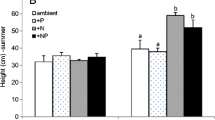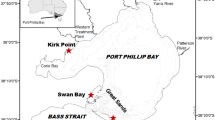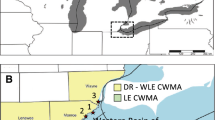Abstract
We investigated if the success of the invasive common reed Phragmites australis could be attributed to a competitive ability to use dissolved organic nitrogen (DON) when compared to the dominant macrophyte Spartina alterniflora in tidal wetlands. Short-term nutrient uptake experiments were performed in the laboratory on two genetic lineages of Phragmites (native and introduced to North America) and S. alterniflora. Our results provide the first evidence for direct assimilation of DON by temperate marsh plants and indicate that amino acids are assimilated intact by all plant types at similar rates. Both Phragmites lineages had significantly greater urea–N assimilation rates than S. alterniflora, and the affinity for dissolved inorganic nitrogen (DIN) species was the greatest in native Phragmites > introduced Phragmites > S. alterniflora. Field studies demonstrated uptake of both DON and DIN in similar proportion as those determined in the laboratory experiments. Based on these uptake rates, we estimate that DON has the potential to account for up to 47% of N demand for Phragmites plants, and up to 24% for S. alterniflora plants. Additionally, we suggest that differences in N uptake between native and introduced Phragmites lineages explain one mechanism for the success of the introduced type under increasingly eutrophic conditions.






Similar content being viewed by others
References
Angradi, T.R., S.M. Hagan, and K.W. Able. 2001. Vegetation type and the intertidal macroinvertebrate fauna of a brackish marsh: Phragmites vs Spartina. Wetlands 21: 75–92.
Berg, P., and K.J. McGlathery. 2001. A high-resolution pore water sampler for sandy sediments. Limnology and Oceanography 46: 203–210.
Bertness, M.D., P.J. Ewanchuk, and B.R. Silliman. 2002. Anthropogenic modification of New England salt marsh landscapes. Proceedings of the National Academy of Sciences of the United States of America 99: 1395–1398.
Blossey, B. 2002. Phragmites: Common reed. Morphological Differences Between Native and Introduced Genotypes. http://invasiveplants.net/phragmites/morphology.htm. Accessed on: June 11.
Bradley, P.M., and J.T. Morris. 1990. Influence of oxygen and sulfide concentration on nitrogen uptake kinetics in Spartina alterniflora. Ecology 71: 282–287.
Bradley, P.M., and J.T. Morris. 1991. The influence of salinity on the kinetics of Nh4+ uptake in Spartina alterniflora. Oecologia 85: 375–380.
Buchsbaum, R.N., J. Catena, E. Hutchins, and M.J. James-Pirri. 2006. Changes in salt marsh vegetation, Phragmites australis, and nekton in response to increased tidal flushing in a New England salt marsh. Wetlands 26: 544–557.
Burdige, D.J., and C.S. Martens. 1988. Biogeochemical cycling in an organic-rich coastal marine basin. 10. The role of amino-acids in sedimentary carbon and nitrogen cycling. Geochimica et Cosmochimica Acta 52: 1571–1584.
Burdige, D.J., and C.S. Martens. 1990. Biogeochemical cycling in an organic-rich coastal marine basin. 11. The sedimentary cycling of dissolved, free amino-acids. Geochimica et Cosmochimica Acta 54: 3033–3052.
Burdige, D.J., and S.L. Zheng. 1998. The biogeochemical cycling of dissolved organic nitrogen in estuarine sediments. Limnology and Oceanography 43: 1796–1813.
Burke, D.J., E.P. Hamerlynck, and D. Hahn. 2002. Interactions among plant species and microorganisms in salt marsh sediments. Applied and Environmental Microbiology 68: 1157–1164.
Burke, D.J., E.P. Hamerlynck, and D. Hahn. 2003. Interactions between the salt marsh grass Spartina patens, arbuscular mycorrhizal fungi and sediment bacteria during the growing season. Soil Biology & Biochemistry 35: 501–511.
Chambers, R.M., L.A. Meyerson, and K. Saltonstall. 1999. Expansion of Phragmites australis into tidal wetlands of North America. Aquatic Botany 64: 261–273.
Chambers, R.M., T.J. Mozdzer, and J.C. Ambrose. 1998. Effects of salinity and sulfide on the distribution of Phragmites australis and Spartina alterniflora in a tidal saltmarsh. Aquatic Botany 62: 161–169.
Chambers, R.M., D.T. Osgood, D.J. Bart, and F. Montalto. 2003. Phragmites australis invasion and expansion in tidal wetlands: Interactions among salinity, sulfide, and hydrology. Estuaries 26: 398–406.
Cooke, J.C., R.H. Butler, and G. Madole. 1993. Some observations on the vertical-distribution of vesicular-arbuscular mycorrhizae in roots of salt-marsh grasses growing in saturated soils. Mycologia 85: 547–550.
Cooke, J.C., and M.W. Lefor. 1998. The mycorrhizal status of selected plant species from Connecticut wetlands and transition zones. Restoration Ecology 6: 214–222.
Cornell, S., A. Rendell, and T. Jickells. 1995. Atmospheric inputs of dissolved organic nitrogen to the oceans. Nature 376: 243–246.
Deng, X., W.H. Ye, H.L. Feng, Q.H. Yang, H.L. Cao, K.Y. Hui, and Y. Zhang. 2004. Gas exchange characteristics of the invasive species Mikania micrantha and its indigenous congener M. cordata (Asteraceae) in South China. Botanical Bulletin of Academia Sinica 45: 213–220.
Epstein, E. 1961. The essential role of calcium in selective cation transport by plant cells. Plant Physiology 36(4): 437–444.
Epstein, E., W.E. Schmid, and D.W. Rains. 1963. Significance and technique of short-term experiments on solute absorption by plant tissue. Plant & Cell Physiology 4: 79–83.
Falkengren-Grerup, U., K.F. Mansson, and M.O. Olsson. 2000. Uptake capacity of amino acids by ten grasses and forbs in relation to soil acidity and nitrogen availability. Environmental and Experimental Botany 44: 207–219.
Galloway, J.N., F.J. Dentener, D.G. Capone, E.W. Boyer, R.W. Howarth, S.P. Seitzinger, G.P. Asner, C.C. Cleveland, P.A. Green, E.A. Holland, D.M. Karl, A.F. Michaels, J.H. Porter, A.R. Townsend, and C.J. Vorosmarty. 2004. Nitrogen cycles: Past, present, and future. Biogeochemistry 70: 153–226.
Gardner, W.S., and R.B. Hanson. 1979. Dissolved free amino acids in interstitial waters of Georgia salt marsh soils. Estuaries 2: 113–118.
Goeyens, L., N. Kindermans, M. Abu Yusuf, and M. Elskens. 1998. A room temperature procedure for the manual determination of urea in seawater. Estuarine, Coastal and Shelf Science 47: 415–418.
Guldberg, L.B., K. Finster, N.O.G. Jorgensen, M. Middelboe, and B.A. Lomstein. 2002. Utilization of marine sedimentary dissolved organic nitrogen by native anaerobic bacteria. Limnology and Oceanography 47: 1712–1722.
Hauck, R.D., and J.M. Bremner. 1976. Use of tracers for soil and fertilizer research. Advances in Agronomy 28: 219–260.
Henry, H.A.L., and R.L. Jefferies. 2003. Interactions in the uptake of amino acids, ammonium and nitrate ions in the Arctic salt-marsh grass, Puccinellia phryganodes. Plant Cell and Environment 26: 419–428.
Hoefnagels, M.H., S.W. Broome, and S.R. Shafer. 1993. Vesicular-arbuscular Mycorrhizae in Salt Marshes in North-Carolina. Estuaries 16: 851–858.
Holm, L.G., D.L. Plucknett, J.V. Pancho, and J.P. Herberger. 1977. The World’s worst weeds. Honolulu: University Press of Hawaii.
Kielland, K. 1994. Amino-acid-absorption by arctic plants—Implications for plant nutrition and nitrogen cycling. Ecology 75: 2373–2383.
King, R.S., W.V. Deluca, D.F. Whigham, and P.P. Marra. 2007. Threshold effects of coastal urbanization on Phragmites australis (common reed) abundance and foliar nitrogen in Chesapeake Bay. Estuaries and Coasts 30: 469–481.
Knowles, R., and T.H. Blackburn. 1993. Nitrogen isotope techniques. New York: Academic Press, Inc.
Kormanik, P.P., and A.C. McGraw. 1982. Quantification of vesicular-arbuscular mycorrhizae in plant roots. In Methods and principals of mycorrhizal research, ed. N.C. Schenck, 37–45. St. Paul: The American Phytopathological Society.
League, M.T., E.P. Colbert, D.M. Seliskar, and J.L. Gallagher. 2006. Rhizome growth dynamics of native and exotic haplotypes of Phragmites australis (common reed). Estuaries and Coasts 29: 269–276.
Lipson, D.A., T.K. Raab, S.K. Schmidt, and R.K. Monson. 1999. Variation in competitive abilities of plants and microbes for specific amino acids. Biology and Fertility of Soils 29: 257–261.
Mal, T.K., and L. Narine. 2004. The biology of Canadian weeds. 129. Phragmites australis (Cav.) Trin. ex Steud. Canadian Journal of Plant Science 84: 365–396.
McDowell, S.C.L. 2002. Photosynthetic characteristics of invasive and noninvasive species of Rubus (Rosaceae). American Journal of Botany 89: 1431–1438.
Mendelssohn, I.A., and J.T. Morris. 2000. Eco-physiological controls on the productivity of Spartina alterniflora Loisel. In Concepts and controversies in tidal marsh ecology, ed. M.P. Weinstein and D.A. Kreeger, 59–80. Dordrecht: Kluwer.
Merigout, P., M. Lelandais, F. Bitton, J. P. Renou, X. Briand, C. Meyer, and F. Daniel-Vedele. 2008. Physiological and transcriptomic aspects of urea uptake and assimilation in Arabidopsis plants. Plant Physiology 147: 1225–1238.
Meyerson, L.A., K. Saltonstall, L. Windham, E. Kiviat, and S. Findlay. 2000a. A comparison of Phragmites australis in freshwater and brackish marsh environments in North America. Wetlands Ecology and Management 8: 89–103.
Meyerson, L.A., K.A. Vogt, and R.M. Chambers. 2000b. Linking the success of Phragmites to the alteration of ecosystem nutrient cycles. In Concepts and controversies in tidal marsh ecology, ed. M.P. Weinstein and D.A. Kreeger, 827–844. Dordrecht: Kluwer Academic.
Minchinton, T.E. 2002a. Disturbance by wrack facilitates spread of Phragmites australis in a coastal marsh. Journal of Experimental Marine Biology and Ecology 281: 89–107.
Minchinton, T.E. 2002b. Precipitation during El Nino correlates with increasing spread of Phragmites australis in New England, USA, coastal marshes. Marine Ecology Progress Series 242: 305–309.
Mitsch, W.J., and J.G. Gosselink. 1993. Wetlands, 2nd ed. New York: Van Nostrand Reinhold.
Mozdzer, T. J. and J.C. Zieman. 2010. Ecophysiological differences between genetic lineages facilitate the invasion of non-native Phragmites australis in North American Atlantic coast wetlands. Journal of Ecology 92(2): 451–458.
Mulvenna, P.F., and G. Savidge. 1992. A modified manual method for the determination of urea in seawater using diacetylmonoxime reagent. Estuarine, Coastal and Shelf Science 34: 429–438.
Nasholm, T., A. Ekblad, A. Nordin, R. Giesler, M. Hogberg, and P. Hogberg. 1998. Boreal forest plants take up organic nitrogen. Nature 392: 914–916.
Niering, W.A., R.S. Warren, and C. Weymouth. 1977. Our dynamic tidal marshes: Vegetation changes as revealed by peat analysis. Connecticut Arboretum Bulletin No. 22
Oliver, D.J. 1994. The glycine decarboxylase complex from plant-mitochondria. Annual Review of Plant Physiology and Plant Molecular Biology 45: 323–337.
Orson, R.A. 1999. A paleoecological assessment of Phragmites australis in New England tidal marshes: Changes in plant community structure during the last few millennia. Biological Invasions 1: 149–158.
Park, M.G., and B. Blossey. 2008. Importance of plant traits and Herbivory for invasiveness of Phragmites australis (Poaceae). American Journal of Botany 95: 1557–1568.
Romero, J.A., H. Brix, and F.A. Comin. 1999. Interactive effects of N and P on growth, nutrient allocation and NH4 uptake kinetics by Phragmites australis. Aquatic Botany 64: 369–380.
Saltonstall, K. 2002. Cryptic invasion by a non-native genotype of the common reed, Phragmites australis, into North America. Proceedings of the National Academy of Sciences of the United States of America 99: 2445–2449.
Saltonstall, K., and J.C. Stevenson. 2007. The effect of nutrients on seedling growth of native and introduced Phragmites australis. Aquatic Botany 86: 331–336.
Schmidt, S., and G.R. Stewart. 1999. Glycine metabolism by plant roots and its occurrence in Australian plant communities. Australian Journal of Plant Physiology 26: 253–264.
Schweitzer, J.A., and K.C. Larson. 1999. Greater morphological plasticity of exotic honeysuckle species may make them better invaders than native species. Journal of the Torrey Botanical Society 126: 15–23.
Templer, P., S. Findlay, and C. Wigand. 1998. Sediment chemistry associated with native and non-native emergent macrophytes of a Hudson River marsh ecosystem. Wetlands 18: 70–78.
Thomas, C.R. 2004. Salt marsh biogeochemistry and sediment organic matter accumulation. Ph.D. Charlottesville: University of Virginia.
Tulbure, M.T., D.M. Ghioca, and C.A. Whigham. 2007. Comparative ecology of native and non-native Phragmites australis (common reed) genotypes. Sacremento: Society of Wetland Scientists.
Tyler, A.C., K.J. McGlathery, and I.C. Anderson. 2001. Macroalgae mediation of dissolved organic nitrogen fluxes in a temperate coastal lagoon. Estuarine, Coastal and Shelf Science 53: 155–168.
Tylova-Munzarova, E., B. Lorenzen, H. Brix, and O. Votrubova. 2005. The effects of NH4+ and NO3- on growth, resource allocation and nitrogen uptake kinetics of Phragmites australis and Glyceria maxima. Aquatic Botany 81: 326–342.
Valiela, I., and J.M. Teal. 1979. The nitrogen budget of a salt marsh ecosystem. Nature 280: 652–656.
Verity, P.G. 2002. A decade of change in the Skidaway River estuary. I. Hydrography and nutrients. Estuaries 25: 944–960.
Windham, L. 1999. Effects of an invasive reedgrass, Phragmites australis, on nitrogen cycling in brackish tidal marsh of New York and New Jersey. New Brunswick: Rutgers University.
Windham, L. 2001. Comparison of biomass production and decomposition between Phragmites australis (common reed) and Spartina patens (salt hay grass) in brackish tidal marshes of New Jersey, USA. Wetlands 21: 179–188.
Windham, L., and J.G. Ehrenfeld. 2003. Net impact of a plant invasion on nitrogen-cycling processes within a brackish tidal marsh. Ecological Applications 13: 883–896.
Windham, L., and R.G. Lathrop. 1999. Effects of Phragmites australis (common reed) invasion on aboveground biomass and soil properties in brackish tidal marsh of the Mullica River, New Jersey. Estuaries 22: 927–935.
Windham, L., and L.A. Meyerson. 2003. Effects of common reed (Phragmites australis) expansions on nitrogen dynamics of tidal marshes of the northeastern US. Estuaries 26: 452–464.
Acknowledgements
We would like to thank the LTER Grants DEB 0080381 and DEB 0621014 from the National Science Foundation for funding, John Snyder and Maria Takahashi for assistance in conducting the laboratory experiments, and Aaron Mills for helpful advice. Additionally, two anonymous reviews comments greatly helped improve the manuscript.
Author information
Authors and Affiliations
Corresponding author
Rights and permissions
About this article
Cite this article
Mozdzer, T.J., Zieman, J.C. & McGlathery, K.J. Nitrogen Uptake by Native and Invasive Temperate Coastal Macrophytes: Importance of Dissolved Organic Nitrogen. Estuaries and Coasts 33, 784–797 (2010). https://doi.org/10.1007/s12237-009-9254-9
Received:
Revised:
Accepted:
Published:
Issue Date:
DOI: https://doi.org/10.1007/s12237-009-9254-9




